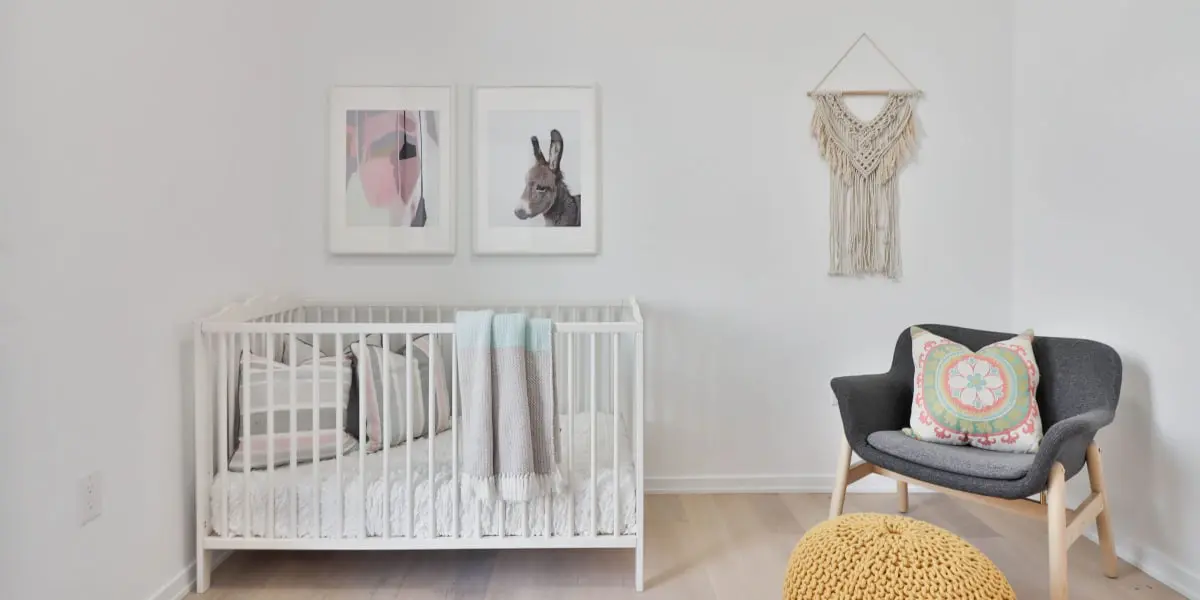What Paint Is Safe for Babies?

Decorating the nursery is one of the most exciting parts of preparing for a new baby. But that harsh chemical smell that comes from new paint might have you thinking: Is this safe for my baby? Using Zero-VOC Paint can help ease those concerns.
Most paints made these days have few health risks. However, children and babies are more susceptible to respiratory issues caused by paint fumes and certain ingredients.
The side effects of fume poisoning can manifest as headaches, dizziness, eye irritation, coughing, and blurred vision.
In order to keep your baby safe, be aware of the ingredients in the paints you select. Here are our tips for choosing baby-safe paint.
Choose Low-VOC or Zero-VOC Paint
The main culprits of those nasty paint fumes are known as VOCs, or volatile organic compounds. This category includes chemicals such as formaldehyde, ethylene glycol, and benzene.
Keep in mind that paint can continue to release fumes even after it is dry. Long-term exposure to VOCs can lead to liver damage or even certain cancers.
In addition to the zero-VOC label, look for paints that include the Greenguard Shield Gold certification, Green Seal (GS-11) certification, or Master Paint Institute Green Performance certification. These federal certifications guarantee the paint follows strict VOC guidelines.
Beware of Additives and APEs
Some acrylic paints include alkylphenol ethoxylates, or APEs. They may also be listed as nonylphenol ethoxylate. You will want to check the ingredients list to be sure this is not included in the paint mix.
Studies have shown these chemicals can show up in breastmilk if the mother is exposed. Furthermore, tests on rats have shown exposure to APEs and their subtypes can cause reproductive and developmental problems.
Other additives should also be avoided. For example, some modern paints can kill bacteria and mildew, or act as a pesticide. This is great in theory, and most people will have no health problems associated with these additives.
However, as we’ve mentioned before, babies have a more sensitive respiratory system. These additives could upset their breathing, especially while they sleep.
Look for Water-Based or Natural Paints
The safest option for babies is water-based or natural paints, as opposed to solvent-based or oil-based paints.
Water-based paints are also known as latex or acrylic. This option uses water as the mixing liquid, so it releases fewer chemicals as it dries.
Natural paints, on the other hand, use non-chemical pigments. This might include milk protein casein, lime, chalk, and clay, and naturally occurring pigments.
Tips for Painting Indoors Safely
Now you know what paint to look for, follow these other tips to ensure you’re painting safely.
- Do not paint while pregnant or nursing.
- Paint the room at least a month in advance before the new baby arrives.
- Maintain proper ventilation, including fans and open windows.
- Be careful when removing old paint, especially if you live in an older house (built prior to 1978) that might contain lead-based paint.
>> Read our guide to keep your pet safe during repainting.>>
If you’re still not sure if painting the nursery is a safe option for you and your baby, it might be best to contact the professionals, and to ask your doctor.
Professional and Safe Painting Services
Here at Armor Tough Coatings, we understand the importance of safety when working with harsh chemicals. That’s why we offer professional residential painting services that you can trust.
We have been painting homes in metro Detroit for nearly a decade. Our attention to detail and selection of high-quality materials has given us a glowing reputation. We treat each home as if it were our own. If we wouldn’t paint our own nursery with a certain paint, we won’t use it on yours, either.


